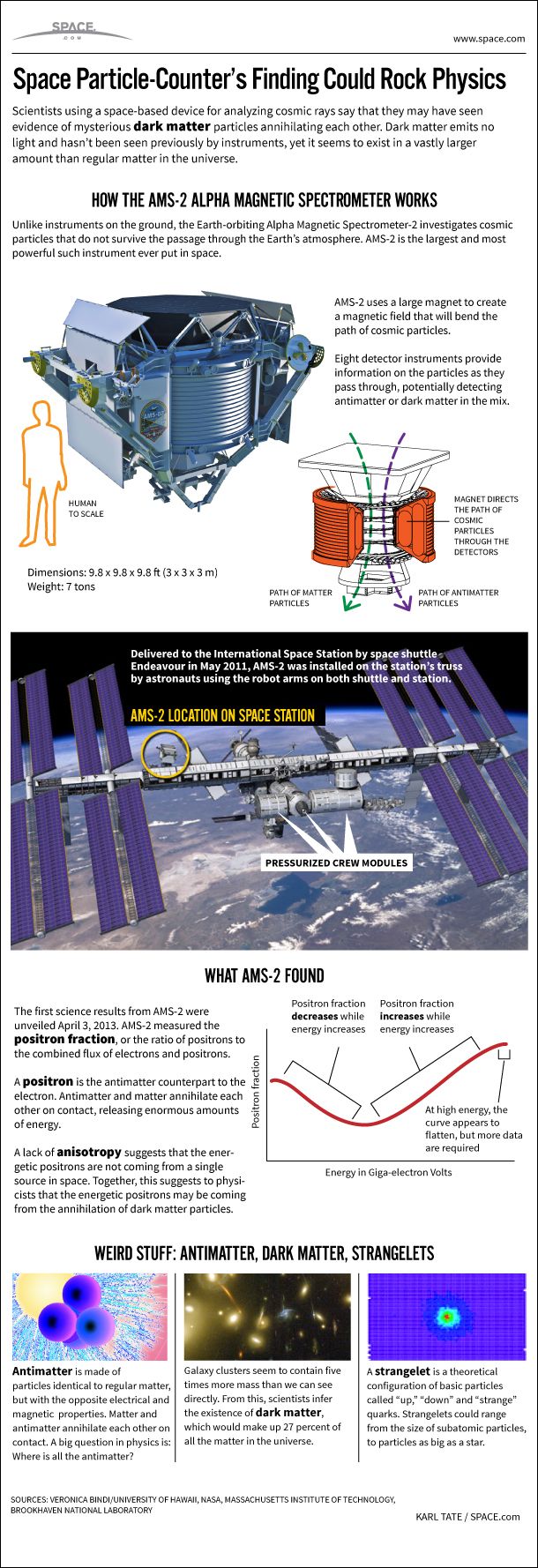How the Antimatter-Hunting Alpha Magnetic Spectrometer Works (Infographic)

Scientists using a space-based device for analyzing cosmic rays say that they may have seen evidence of mysterious dark matter particles annihilating each other. Dark matter emits no light and hasn’t been seen previously by instruments, yet it seems to exist in a vastly larger amount than regular matter in the universe.
Unlike instruments on the ground, the Earth-orbiting Alpha Magnetic Spectrometer-2 investigates cosmic particles that do not survive the passage through the Earth’s atmosphere. AMS-2 is the largest and most powerful such instrument ever put in space.
Big Story: Dark Matter Possibly Found by $2 Billion Space Station Experiment
AMS-2 uses a large magnet to create a magnetic field that will bend the path of cosmic particles. Eight detector instruments provide information on the particles as they pass through, potentially detecting antimatter or dark matter in the mix.
See the Alpha Magnetic Spectrometer in Space (Photos)
Delivered to the International Space Station by space shuttle Endeavour in 2011, AMS-2 was installed on the station’s truss by astronauts using the robot arms on both shuttle and station.
A positron is the antimatter counterpart to the electron. Antimatter and matter annihilate each other on contact, releasing enormous amounts of energy.
AMS-2 measured the positron fraction, or the ratio of positrons to the combined flux of electrons and positrons.
Video: Sifting Cosmic Sand for Dark Matter
A lack of anisotropy suggests that the energetic positrons are not coming from a single source in space. Together, this suggests to physicists that the energetic positrons may be coming from the annihilation of dark matter particles.
Antimatter is made of particles identical to regular matter, but with the opposite electrical and magnetic properties. Matter and antimatter annihilate each other on contact. A big question in physics is: Where is all the antimatter?
Galaxy clusters seem to contain five times more mass than we can see directly. From this, scientists infer the existence of dark matter, which would make up 27 percent of all the matter in the universe. [8 Baffling Astronomy Mysteries]
A strangelet is a theoretical configuration of basic particles called “up,” “down” and “strange” quarks. Strangelets could range from the size of subatomic particles, to particles as big as a star.Scientists using a space-based device for analyzing cosmic rays say that they may have seen evidence of mysterious dark matter particles annihilating each other. Dark matter emits no light and hasn’t been seen previously by instruments, yet it seems to exist in a vastly larger amount than regular matter in the universe.
Unlike instruments on the ground, the Earth-orbiting Alpha Magnetic Spectrometer-2 investigates cosmic particles that do not survive the passage through the Earth’s atmosphere. AMS-2 is the largest and most powerful such instrument ever put in space.
AMS-2 uses a large magnet to create a magnetic field that will bend the path of cosmic particles. Eight detector instruments provide information on the particles as they pass through, potentially detecting antimatter or dark matter in the mix.
Delivered to the International Space Station by space shuttle Endeavour in 2011, AMS-2 was installed on the station’s truss by astronauts using the robot arms on both shuttle and station.
A positron is the antimatter counterpart to the electron. Antimatter and matter annihilate each other on contact, releasing enormous amounts of energy.
AMS-2 measured the positron fraction, or the ratio of positrons to the combined flux of electrons and positrons.
A lack of anisotropy suggests that the energetic positrons are not coming from a single source in space. Together, this suggests to physicists that the energetic positrons may be coming from the annihilation of dark matter particles.
Antimatter is made of particles identical to regular matter, but with the opposite electrical and magnetic properties. Matter and antimatter annihilate each other on contact. A big question in physics is: Where is all the antimatter?
Galaxy clusters seem to contain five times more mass than we can see directly. From this, scientists infer the existence of dark matter, which would make up 27 percent of all the matter in the universe.
A strangelet is a theoretical configuration of basic particles called "up," "down" and "strange" quarks. Strangelets could range from the size of subatomic particles, to particles as big as a star.
- 8 Baffling Astronomy Mysteries
- Twisted Physics: 7 Mind-Blowing Findings
- Wacky Physics: The Coolest Little Particles in Nature
Follow us @Spacedotcom, Facebook and Google+.
Breaking space news, the latest updates on rocket launches, skywatching events and more!
Join our Space Forums to keep talking space on the latest missions, night sky and more! And if you have a news tip, correction or comment, let us know at: community@space.com.

Karl's association with Space.com goes back to 2000, when he was hired to produce interactive Flash graphics. From 2010 to 2016, Karl worked as an infographics specialist across all editorial properties of Purch (formerly known as TechMediaNetwork). Before joining Space.com, Karl spent 11 years at the New York headquarters of The Associated Press, creating news graphics for use around the world in newspapers and on the web. He has a degree in graphic design from Louisiana State University and now works as a freelance graphic designer in New York City.
